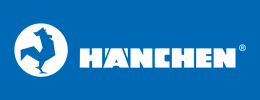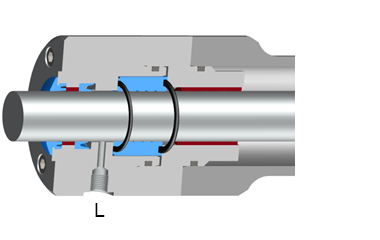Longitudinal carriage drive in multi-spindle automatic lathe
Industrial hydraulic cylinder for machine tools
Multi-spindle automatic lathes are a basic requirement for efficient and precise series production in which complex bodies are turned from metal. These have been a product focus of the mechanical engineering company Alfred H. Schütte in Cologne since 1915, when it launched the first 4-spindle automatic lathe on the market. In these machines, several cutting tools cut the workpiece simultaneously, which reduces the cycle time to a fraction of that of a simple lathe with successively changing tools.
Schütte has repeatedly redefined the limits of what is possible with these automatic lathes, both in terms of cycle times and precision. To achieve this, hydraulic cylinders from Hänchen with a resolution of 0.1 μm are used in the longitudinal slides.
- Extremely long service intervals
- Space-saving design
- Force and speed are simultaneously available at full capacity
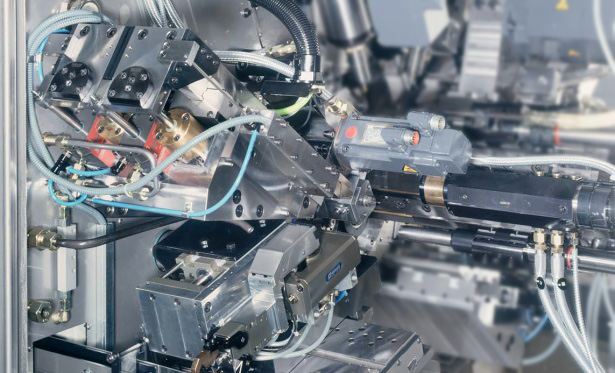
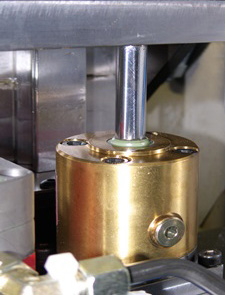
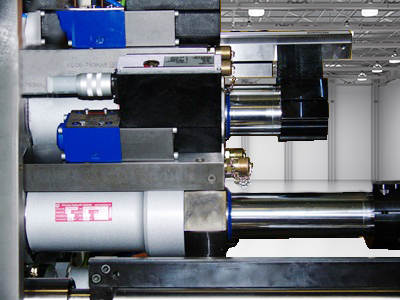
Requirements for the hydraulic cylinders
- Compact design
- Position transducer for a resolution of 0.1 μm
- Very low friction
- Limited mounting space
- Precision, more accurate than 1 μm
- High durability, as changing the seal is very time-consuming
Today as many as eight spindles can be used simultaneously in one lathe. They are fixed in a circle around the central axis of rotation. Since the installation space is limited, the feed drives of the spindles are nested closely into each other. This results in high demands as regards compact design. Precision higher than 1 μm puts special demands on feed drives, accuracy, speed, power and compactness which these machines have to combine. This has been for a long time a typical application area for hydraulic cylinders which have been provided for the plain turning slide of these machines by Herbert Hänchen GmbH & Co. KG from Ostfildern. There are up to fifteen cylinders per machine.
“We experienced serious quality problems with another producer for a long period of time", says Dr.-Ing. Albert Herrscher, member of the executive board at Schütte. “That’s why we have gone over to Hänchen. Hänchen has then designed to our order a double rod cylinder for the plain turning slide drive with integrated glass scale that meets 0.1 μm resolution. Ever since we started using these cylinders quality is no controversial issue anymore.” Hydraulic cylinder is the key component of a precise system for this company from Cologne. Other important components are the valve and the superordinate closed loop position control which can be addressed depending on machine type either by an industrial PC with decentralised sensors connected to ProfiBUS V2 or by a CNC control. Thus in 1992 the classical technology of mechanical cam drives and so called hybrid solutions was replaced by electromechanical units. For especially long workpieces Schütte still uses electrical drives. According to current state-of-the-art the valves are the component that sets limits for this technology by allowing maximum flow of 25 l/min having the system pressure of 100 bar. Hänchen hydraulic cylinders would be able to cope with other dimensions smoothly. The cross slide drive contains in some machine types cartridge solution integrated into the slide including a single rod cylinder. Electronic compensation enables in this case the needed precision, while allowing especially accurate control of double rod cylinder due to its symmetrical construction. Due to direct integration into the slide stability is especially important for these cylinders because changing seals or replacement would be very complex. Dr.-Ing. Herrscher says: “Now that we have cylinders by Hänchen it’s not a problem anymore! Install them and then you can forget about them.”
Besides positional accuracy, stability and force density Hänchen hydraulics offers further advantageous features: The wiring for example is located in machine foundation plate which is made of concrete polymer for accuracy reasons. This integration form is not so easily realised with electric main. Therewith the customer gets a compact unit with only very few connections. Hydraulic linear drives described above provide feed force of up to 4500 N to rotate the workpiece with up to 7,000 rpm with maximum torque of 50 Nm. Because of extremely high requirements to precision and the absence of transverse forces floating annular gap sealing patented by Hänchen is applied in the Hänchen cylinders delivered to Schütte. This “Servofloat® quality” functions almost friction-free. For extremely slow and very fast movements it enables non-contact pressure drop to the outside and low leakage. Therefore these cylinders provide the highest positioning and repetitive accuracy and are stick-slip-free.
The sealing combinations work according to the following principle: When the system starts, a hydrodynamic oil flow is built up in the annular gap seal via the cylinder chambers so that the annular gap seal centres radially around the piston rod, without metal contact, in a "floating" way. The pressure deforms a steel liner and forms a throttle gap which appears as a contact-free sealing gap of a few 1/100 mm. This process, however, works only with a production accuracy in the range of a few μm. Otherwise the leakage will cause high hydraulic losses. Via a collective connection, the escaping leak oil is fed back into the fluid cycle without pressure. The static and dynamic friction in the cylinder is minimised by the lack of a tangential seal subject to pressure. Only with minimum leakage does the annular gap seal have a pressure-reducing function. Therefore the piston rod is guided via guide bands with optimised friction. All the same, even a cylinder with a floating annular gap seal can absorb relatively high transverse forces. Another convincing argument in favour of cylinders with a floating annular gap seal is the price. Cylinders of this type differ from cylinders with hydrostatically supported piston rod guides only in lower lateral forces that are admissible, but offer a cost benefit of approx. 30 %.

Figure 1: Cartridge solution with single-rod cylinder
Figure 2: Multi-spindle automatic lathe
Schütte is the only company that applies hydraulics as basic technology for multi-spindle automatic lathes. Only one out of four competitors worldwide provides a single machine type with hydraulic drive as well. “Thanks to this technological leadership we are able to open up new dimensions of performance for our customers", points out Dr.-Ing. Herrscher. “Because no matter how important the price is, quality and precision are still major benchmarks for Schütte.” In Cologne alone the company has 540 employees, among them 60 trainees, and achieves a turnover of ca. 80 Mio Euro annually. Alongside with multi-spindle automatic lathes this mechanical engineering company has also specialised in tool grinding and universal grinding machines. With its 50 % export share the company distributes these products through its subsidiaries in France, Japan, Spain, USA and China. Japan and Italy are especially important foreign markets. Two branches are in the focus of public interest: Production of brass fittings as well as automotive and automotive supplier industry. A member of the executive board sums it up: „There are both worlds and we apply both technologies which are comparable in price. Electric actuating drives allow similar precision as the hydraulics. However, this determines compromises as regards compactness, force and acceleration, which are avoided when applying hydraulic systems. That's why we would use hydraulics in other machines, if not for the flow limitations at the valves Since we have developed in the long term the needed expertise in hydraulics and have the command of system integration. In the long run we have gained trust of our customers. Hydraulic cylinders by Hänchen have made their significant contribution to it.”
Read more about Hänchen servo cylinders at: Servo hydraulic actuators - Hydraulic servo actuators with valves and sensor technology.
Jörg Beyer, mediaword
© Hänchen 2007
